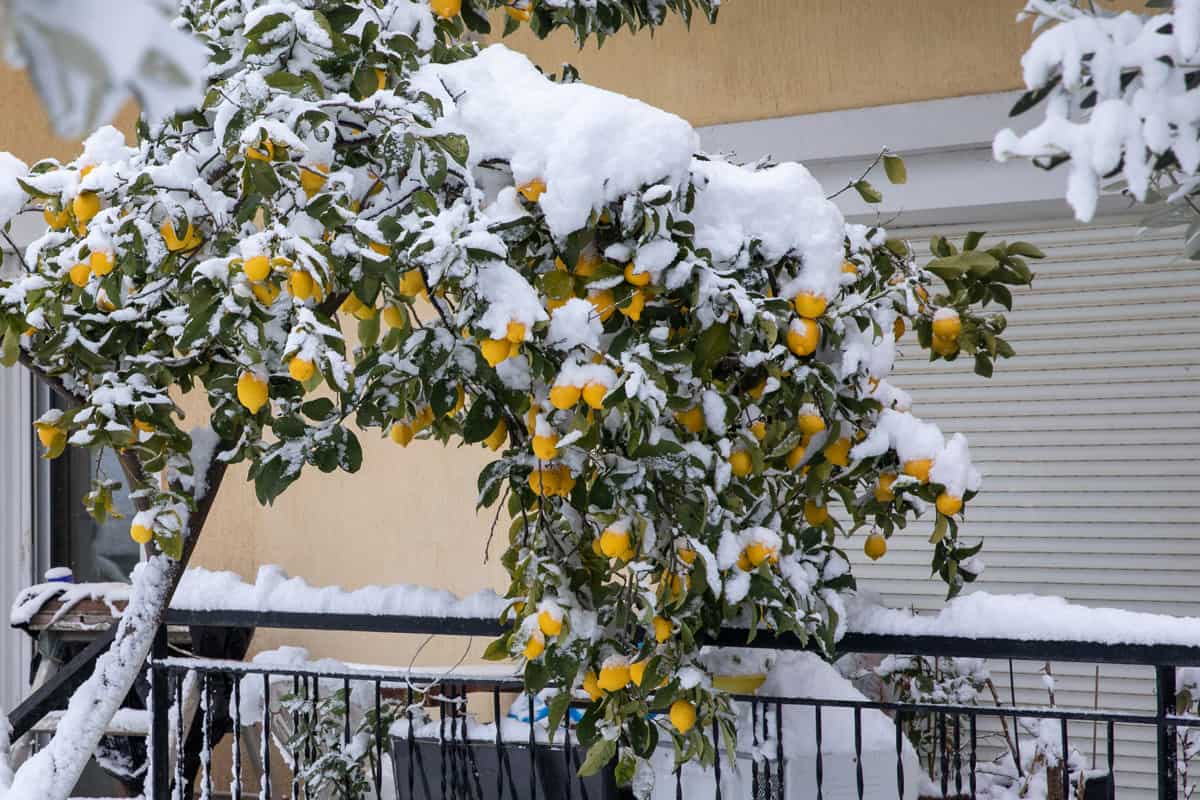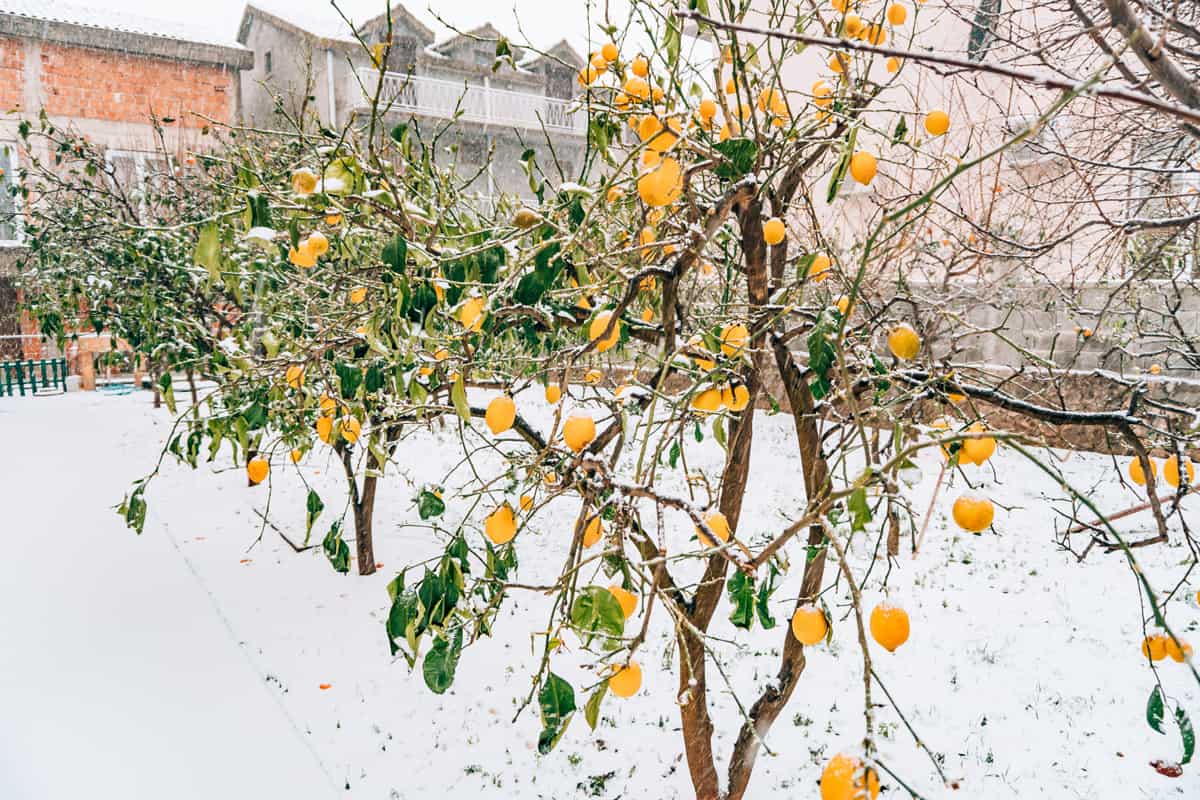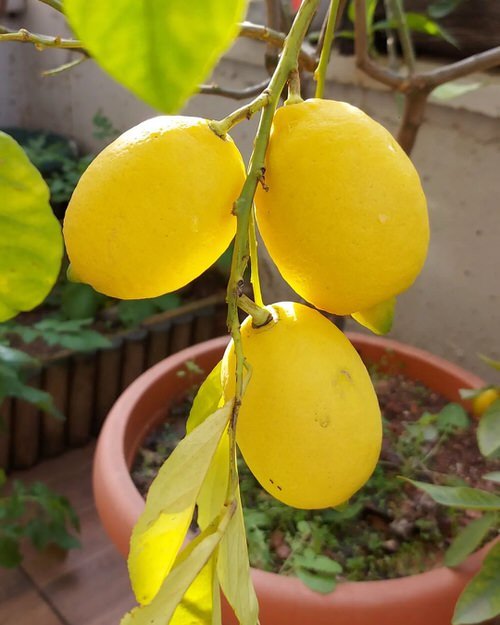Understanding Lemon Tree Hardiness: Can They Withstand Frost?
Lemon trees are typically hardy in USDA zones 9-11, meaning they thrive in temperatures between 65°F and 90°F (18°C and 32°C). However, they can be sensitive to frost, which can damage or kill the tree. To determine if your lemon tree can survive winter outside, it’s essential to understand the concept of hardiness zones and how they relate to your specific region.
Hardiness zones are defined by the average annual extreme minimum temperature in a given area. Lemon trees can tolerate some frost but may not survive prolonged periods of temperatures below 25°F (-4°C). If you live in an area with frequent frosts, it’s crucial to take measures to protect your lemon tree from damage.
While lemon trees can’t survive harsh winters outside in colder climates, there are ways to help them thrive in cooler temperatures. By understanding your tree’s hardiness zone and taking steps to protect it from frost, you can enjoy a healthy and productive lemon tree year-round. For example, in zones 4-8, lemon trees can be grown in containers and brought indoors during the winter months to protect them from frost.
In warmer climates, such as zones 9-11, lemon trees can be grown outside year-round, but they still require protection from extreme cold snaps. By choosing a variety of lemon tree that is tolerant of cooler temperatures, such as the ‘Meyer’ or ‘Dwarf Washington’ varieties, you can increase the chances of your tree surviving winter outside.
Ultimately, the key to helping your lemon tree survive winter outside is to understand its hardiness zone and take steps to protect it from frost. By doing so, you can enjoy a healthy and productive tree that provides delicious fruit for years to come.
Preparing Your Lemon Tree for Winter: Essential Steps
As the winter months approach, it’s essential to prepare your lemon tree for the cold weather ahead. Proper preparation can help protect your tree from extreme cold and wind, ensuring it remains healthy and thrives year-round. One of the most critical steps in preparing your lemon tree for winter is pruning.
Pruning your lemon tree in the fall helps remove any dead or damaged branches, promoting healthy growth and reducing the risk of disease. It’s also an excellent opportunity to shape your tree, encouraging a strong and sturdy structure that can withstand harsh winter conditions. When pruning, make sure to remove any weak or spindly growth, as this can help prevent damage from snow and ice.
In addition to pruning, fertilization is also crucial in preparing your lemon tree for winter. A balanced fertilizer applied in the fall can help promote root growth, ensuring your tree is well-equipped to handle the cold weather ahead. However, be cautious not to over-fertilize, as this can cause more harm than good.
Pest management is another critical aspect of preparing your lemon tree for winter. Regularly inspect your tree for signs of pests, such as aphids, whiteflies, and spider mites. If you notice any infestations, treat your tree promptly with insecticidal soap or neem oil. This will help prevent the spread of disease and ensure your tree remains healthy throughout the winter months.
Protecting your lemon tree from extreme cold and wind is also vital. If you live in an area prone to harsh winters, consider using a frost blanket or bringing your potted tree indoors. This will help shield your tree from extreme temperatures and wind, ensuring it remains healthy and thrives year-round.
By following these essential steps, you can help prepare your lemon tree for the winter months ahead. Remember, proper care and protection are critical in ensuring your tree remains healthy and thrives year-round. With the right preparation, your lemon tree can survive winter outside and continue to provide delicious fruit for years to come.
How to Protect Your Lemon Tree from Frost Damage
Frost damage can be a significant threat to lemon trees, especially in areas where temperatures drop below 25°F (-4°C). To protect your tree from frost damage, there are several methods you can use, each with its pros and cons. One of the most effective ways to protect your lemon tree from frost is to use a frost blanket.
A frost blanket is a lightweight, breathable cloth that can be draped over the tree to protect it from frost. These blankets are usually made of a porous material that allows moisture and air to reach the tree while keeping frost out. They are easy to install and can be reused year after year. However, they may not provide complete protection in extreme cold snaps.
Another option for protecting your lemon tree from frost is to bring potted trees indoors. This is a great option for small trees or for those who live in areas with extremely cold winters. By bringing your tree indoors, you can provide it with a warm and cozy environment that is protected from frost. However, this method may not be practical for larger trees or for those who do not have enough indoor space.
Anti-desiccant sprays are another method for protecting lemon trees from frost damage. These sprays work by coating the leaves and branches of the tree with a waxy substance that helps to prevent moisture loss. This can be especially helpful in areas where the air is dry and cold. However, these sprays may not provide complete protection in extreme cold snaps and may need to be reapplied regularly.
Other methods for protecting lemon trees from frost damage include using heaters, wind machines, and sprinkler systems. Heaters can be used to warm the air around the tree, while wind machines can be used to circulate the air and prevent cold pockets from forming. Sprinkler systems can be used to spray water on the tree, which can help to raise the temperature and prevent frost damage.
Ultimately, the best method for protecting your lemon tree from frost damage will depend on your specific climate and the size and type of tree you have. By choosing the right method and taking the necessary precautions, you can help to ensure that your lemon tree survives the winter months and continues to thrive year-round.
Creating a Microclimate: Tips for Growing Lemon Trees in Cold Climates
While lemon trees typically thrive in warm and sunny climates, it’s possible to create a microclimate that allows them to grow in colder regions. A microclimate is a small, localized area with a unique set of environmental conditions that differ from the surrounding area. By creating a microclimate, you can provide your lemon tree with the warm and sunny conditions it needs to thrive, even in cold climates.
One of the most effective ways to create a microclimate for your lemon tree is to use a greenhouse. Greenhouses are designed to trap heat and sunlight, creating a warm and cozy environment that’s perfect for growing lemon trees. They can be made from a variety of materials, including glass, plastic, and polycarbonate, and can be customized to fit your specific needs.
Another option for creating a microclimate is to use a cold frame. Cold frames are essentially mini-greenhouses that are designed to protect plants from frost and cold temperatures. They’re typically made from wood or plastic and are covered with a clear lid that allows sunlight to enter. By placing your lemon tree in a cold frame, you can provide it with the protection it needs to survive cold winters.
In addition to greenhouses and cold frames, there are several other techniques you can use to create a microclimate for your lemon tree. These include using row covers, which are lightweight, breathable fabrics that can be draped over the tree to protect it from frost and wind. You can also use mulch to insulate the soil and retain heat, or use a heating mat to warm the soil and air around the tree.
When creating a microclimate for your lemon tree, it’s essential to consider the specific needs of the tree. Lemon trees prefer well-draining soil and full sun, so make sure to provide your tree with these conditions. You should also ensure that your microclimate is well-ventilated to prevent the buildup of moisture and reduce the risk of disease.
By creating a microclimate for your lemon tree, you can provide it with the conditions it needs to thrive, even in cold climates. With a little creativity and planning, you can enjoy a healthy and productive lemon tree year-round, even in areas where the winters are cold and harsh.
Choosing the Right Lemon Tree Variety for Your Climate
When it comes to growing lemon trees, choosing the right variety for your climate is crucial. Different varieties of lemon trees have varying levels of cold hardiness, and some are better suited to certain climates than others. By selecting a variety that is well-suited to your climate, you can help ensure that your lemon tree thrives year-round.
One of the most popular varieties of lemon trees is the ‘Eureka’ lemon. This variety is known for its high yields and is well-suited to warm and sunny climates. However, it is not as cold-hardy as some other varieties and may not be the best choice for areas with frequent frosts.
Another popular variety is the ‘Meyer’ lemon. This variety is a cross between a lemon and an orange, and is known for its sweet and tangy flavor. It is also more cold-hardy than the ‘Eureka’ variety and can tolerate temperatures as low as 20°F (-7°C).
For areas with extremely cold winters, the ‘Dwarf Washington’ variety is a good choice. This variety is a compact, dwarf tree that is well-suited to containers and can tolerate temperatures as low as 10°F (-12°C).
Other varieties of lemon trees, such as the ‘Lisbon’ and ‘Sorrento’, are also available and may be well-suited to certain climates. It’s essential to research the specific needs and characteristics of each variety to determine which one is best for your area.
In addition to choosing the right variety, it’s also essential to consider the specific growing conditions in your area. Lemon trees prefer well-draining soil and full sun, so make sure to provide your tree with these conditions. By selecting the right variety and providing the right growing conditions, you can help ensure that your lemon tree thrives year-round.
Ultimately, the key to growing a healthy and productive lemon tree is to choose a variety that is well-suited to your climate and provide it with the right growing conditions. By doing so, you can enjoy a bountiful harvest of delicious lemons year-round.
Common Mistakes to Avoid When Winterizing Your Lemon Tree
When it comes to winterizing your lemon tree, there are several common mistakes that can harm or kill the tree. By avoiding these mistakes, you can help ensure that your lemon tree survives the winter months and thrives year-round.
One of the most common mistakes is over-watering. Lemon trees prefer well-draining soil and can be susceptible to root rot if the soil is too wet. During the winter months, it’s essential to reduce watering to once a month, or even less if the tree is dormant.
Another mistake is under-pruning. Pruning is essential for maintaining the health and shape of your lemon tree. During the winter months, it’s crucial to prune any dead or damaged branches to prevent the spread of disease and encourage new growth.
Failing to protect your lemon tree from extreme cold is another common mistake. Lemon trees can be damaged or killed by frost, so it’s essential to provide protection during the winter months. This can include using frost blankets, bringing potted trees indoors, or using anti-desiccant sprays.
Not providing enough sunlight is another mistake that can harm your lemon tree. Lemon trees prefer full sun, so it’s essential to provide them with enough sunlight during the winter months. If possible, move your lemon tree to a sunnier location or use grow lights to supplement the natural light.
Finally, not monitoring your lemon tree’s temperature is a common mistake. Lemon trees prefer temperatures between 65°F and 75°F (18°C and 24°C), so it’s essential to monitor the temperature and provide protection if it drops below 50°F (10°C).
By avoiding these common mistakes, you can help ensure that your lemon tree survives the winter months and thrives year-round. Remember to reduce watering, prune regularly, provide protection from extreme cold, provide enough sunlight, and monitor the temperature to keep your lemon tree healthy and happy.
Post-Winter Care: How to Revive Your Lemon Tree in Spring
After a long winter, your lemon tree may need some extra care to revive it and get it ready for the growing season. In this section, we’ll provide guidance on how to care for your lemon tree after the winter months, including pruning, fertilization, and pest management.
Pruning is an essential part of post-winter care for lemon trees. Remove any dead or damaged branches, and shape the tree to maintain its desired shape. This will help promote healthy growth and encourage the tree to produce new fruit.
Fertilization is also crucial for post-winter care. Lemon trees need a balanced fertilizer that is high in nitrogen, phosphorus, and potassium. Apply a fertilizer specifically formulated for citrus trees, and follow the instructions on the label for application rates and timing.
Pest management is another important aspect of post-winter care. Check your tree for any signs of pests, such as aphids, whiteflies, or spider mites. If you find any pests, treat your tree with insecticidal soap or neem oil, and repeat as necessary.
Gradual exposure to outdoor conditions is also essential for post-winter care. If your lemon tree has been indoors during the winter, it’s essential to acclimate it to outdoor conditions gradually. Start by moving the tree to a shaded area outdoors, and then gradually move it to a sunnier location over the course of a few weeks.
Finally, keep an eye out for any signs of disease or nutrient deficiencies. Lemon trees can be susceptible to diseases such as root rot and leaf spot, so monitor your tree regularly and take action if you notice any signs of disease.
By following these post-winter care tips, you can help revive your lemon tree and get it ready for the growing season. Remember to prune, fertilize, manage pests, and provide gradual exposure to outdoor conditions to ensure your tree thrives year-round.
Conclusion: With Proper Care, Your Lemon Tree Can Thrive Year-Round
In conclusion, with proper care and protection, your lemon tree can thrive year-round, even in cold climates. By understanding the concept of hardiness zones and how they relate to lemon trees, preparing your tree for winter, protecting it from frost damage, creating a microclimate, choosing the right variety, avoiding common mistakes, and providing post-winter care, you can help ensure that your lemon tree survives the winter months and continues to produce delicious fruit.
Remember, can lemon trees survive winter outside? The answer is yes, with proper care and protection. By following the tips and techniques outlined in this article, you can help your lemon tree thrive year-round and enjoy a bountiful harvest of fresh, juicy lemons.
Don’t let the cold winter months get in the way of enjoying your lemon tree’s delicious fruit. With a little care and attention, you can help your tree survive the winter and continue to thrive year-round. Try the tips and techniques outlined in this article and see the difference for yourself.
By providing your lemon tree with the proper care and protection, you can help ensure that it continues to thrive year-round and provide you with a bountiful harvest of fresh, juicy lemons. So, don’t wait any longer, start taking care of your lemon tree today and enjoy the many benefits it has to offer.








